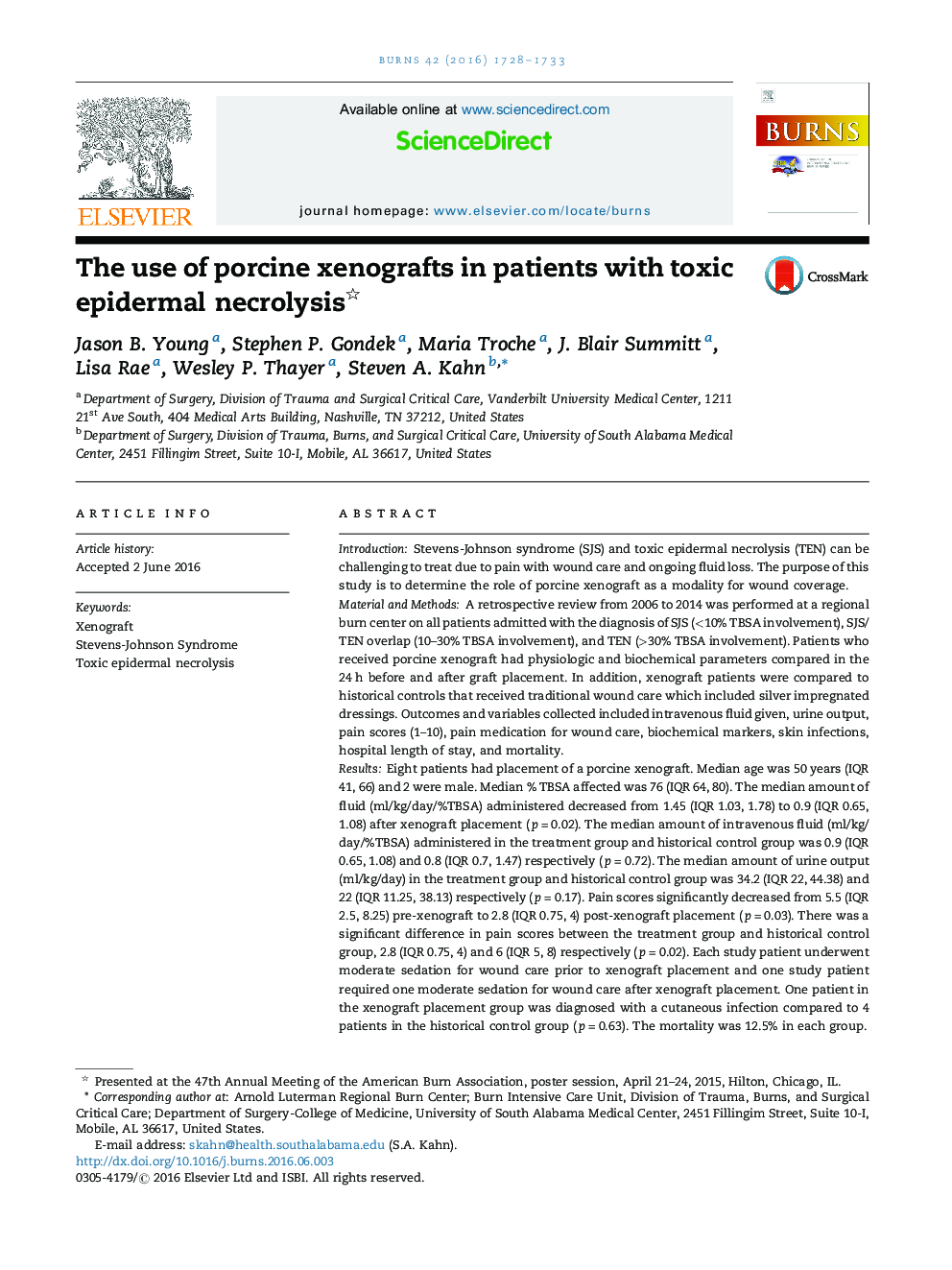| کد مقاله | کد نشریه | سال انتشار | مقاله انگلیسی | نسخه تمام متن |
|---|---|---|---|---|
| 5636196 | 1406664 | 2016 | 6 صفحه PDF | دانلود رایگان |
- First study to compare outcomes with a non-xenograft control group.
- Investigates physiologic changes between pre- and post-xenograft placement states.
- Porcine xenograft reduces IV fluid use in TEN patients.
- Porcine xenograft reduces pain scores and pain med use in TEN patients.
IntroductionStevens-Johnson syndrome (SJS) and toxic epidermal necrolysis (TEN) can be challenging to treat due to pain with wound care and ongoing fluid loss. The purpose of this study is to determine the role of porcine xenograft as a modality for wound coverage.Material and MethodsA retrospective review from 2006 to 2014 was performed at a regional burn center on all patients admitted with the diagnosis of SJS (<10% TBSA involvement), SJS/TEN overlap (10-30% TBSA involvement), and TEN (>30% TBSA involvement). Patients who received porcine xenograft had physiologic and biochemical parameters compared in the 24 h before and after graft placement. In addition, xenograft patients were compared to historical controls that received traditional wound care which included silver impregnated dressings. Outcomes and variables collected included intravenous fluid given, urine output, pain scores (1-10), pain medication for wound care, biochemical markers, skin infections, hospital length of stay, and mortality.ResultsEight patients had placement of a porcine xenograft. Median age was 50 years (IQR 41, 66) and 2 were male. Median % TBSA affected was 76 (IQR 64, 80). The median amount of fluid (ml/kg/day/%TBSA) administered decreased from 1.45 (IQR 1.03, 1.78) to 0.9 (IQR 0.65, 1.08) after xenograft placement (p = 0.02). The median amount of intravenous fluid (ml/kg/day/%TBSA) administered in the treatment group and historical control group was 0.9 (IQR 0.65, 1.08) and 0.8 (IQR 0.7, 1.47) respectively (p = 0.72). The median amount of urine output (ml/kg/day) in the treatment group and historical control group was 34.2 (IQR 22, 44.38) and 22 (IQR 11.25, 38.13) respectively (p = 0.17). Pain scores significantly decreased from 5.5 (IQR 2.5, 8.25) pre-xenograft to 2.8 (IQR 0.75, 4) post-xenograft placement (p = 0.03). There was a significant difference in pain scores between the treatment group and historical control group, 2.8 (IQR 0.75, 4) and 6 (IQR 5, 8) respectively (p = 0.02). Each study patient underwent moderate sedation for wound care prior to xenograft placement and one study patient required one moderate sedation for wound care after xenograft placement. One patient in the xenograft placement group was diagnosed with a cutaneous infection compared to 4 patients in the historical control group (p = 0.63). The mortality was 12.5% in each group.ConclusionsPlacement of a porcine xenograft in patients with SJS, SJS/TEN overlap, or TEN is associated with a significant reduction in intravenous fluid use, pain scores, and pain medication. Further study with larger sample sizes is warranted to evaluate for statistically significant differences in outcomes after porcine xenograft placement for SJS, SJS/TEN overlap or TEN.
Journal: Burns - Volume 42, Issue 8, December 2016, Pages 1728-1733
